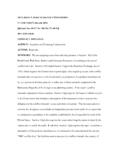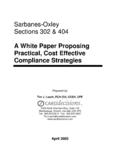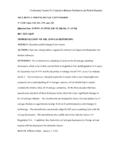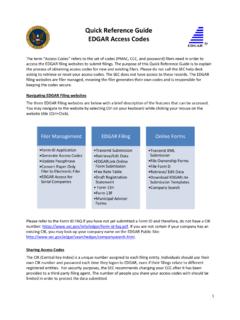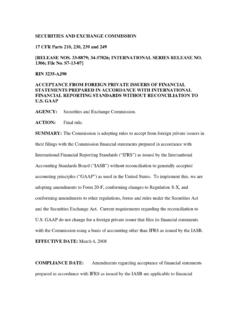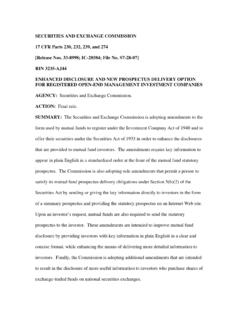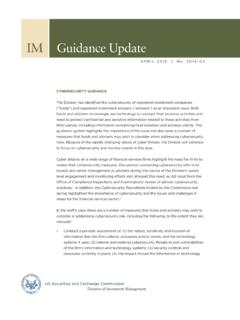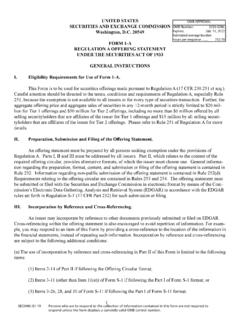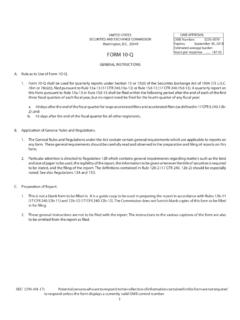Transcription of Variable Annuities: What You Should Know - SEC
1 WHAT YOU Should KNOW | 1 Variable AnnuitiesWhat You Should KnowInformation is an investor s best tool2 | Variable ANNUITIESWHAT YOU Should KNOW | 1 Variable AnnuitiesVariable annuities have become a part of the retirement and investment plans of many Americans. Before you buy a Variable annuity, you Should know some of the basics and be prepared to ask your insurance agent, broker, finan-cial planner, or other financial professional lots of ques-tions about whether a Variable annuity is right for you. This is a general description of Variable annuities what they are, how they work, and the charges you will pay. Before buying any Variable annuity, however, you Should find out about the particular annuity you are consider-ing. Request a prospectus from the insurance company or from your financial professional, and read it carefully. The prospectus contains important information about the annuity contract, including fees and charges, invest-ment options, death benefits, and annuity payout options.
2 You Should compare the benefits and costs of the annuity to other Variable annuities and to other types of invest-ments, such as mutual Securities and Exchange CommissionOffice of Investor Education and Advocacy100 F Street, NEWashington, DC 20549-0213 Telephone: (800) | Variable ANNUITIEST able of ContentsWHAT IS A Variable ANNUITY? ..3 HOW Variable ANNUITIES WORK ..5 The Accumulation Phase ..5 The Payout Phase ..6 THE DEATH BENEFIT AND OTHER FEATURES ..8 Variable ANNUITY CHARGES ..10 TAX-FREE 1035 EXCHANGES ..13 BONUS CREDITS ..14 ASK QUESTIONS BEFORE YOU INVEST ..17 FOR MORE INFORMATION ..19 WHAT YOU Should KNOW | 3 What Is a Variable Annuity?A Variable annuity is a contract between you and an insurance company, under which the insurer agrees to make periodic pay-ments to you, beginning either immediately or at some future date. You purchase a Variable annuity contract by making either a single purchase payment or a series of purchase payments.
3 A Variable annuity offers a range of investment options. The value of your investment as a Variable annuity owner will vary depending on the performance of the investment options you choose. The investment options for a Variable annuity are typi-cally mutual funds that invest in stocks, bonds, money market instruments, or some combination of the three. Although Variable annuities are typically invested in mutual funds, Variable annuities differ from mutual funds in several important ways: FIRST, Variable annuities let you receive periodic payments for the rest of your life (or the life of your spouse or any other person you designate). This feature offers protection against the possibility that, after you retire, you will outlive your assets. SECOND, Variable annuities have a death benefit. If you die before the insurer has started making payments to you, your beneficiary is guaranteed to receive a specified amount typi-cally at least the amount of your purchase payments.
4 Your ben-eficiary will get a benefit from this feature if, at the time of your death, your account value is less than the guaranteed amount. THIRD, Variable annuities are tax-deferred. That means you pay no taxes on the income and investment gains from your an-nuity until you withdraw your money. You may also transfer your money from one investment option to another within a Variable annuity without paying tax at the time of the transfer. When you take your money out of a Variable annuity, however, you will be taxed on the earnings at ordinary income tax rates 4 | Variable ANNUITIESCAUTION!Other investment vehicles, such as IRAs and employer-sponsored 401(k) plans, also may provide you with tax-deferred growth and other tax advantages. For most investors, it will be advantageous to make the maximum allowable contributions to IRAs and 401(k) plans before investing in a Variable addition, if you are investing in a Variable annuity through a tax-advantaged retirement plan (such as a 401(k) plan or an IRA), you will get no additional tax advantage from the Variable annuity.
5 Under these circumstances, consider buying a Variable annuity only if it makes sense because of the annuity s other features, such as lifetime income payments and death protection. The tax rules that apply to Variable annuities can be complicated before investing, you may want to consult a tax adviser about the tax consequences to you of investing in a Variable annuities are designed to be long-term investments, to meet retirement and other long-range goals. Variable annuities are not suitable for meeting short-term goals because substantial taxes and insurance company charges may apply if you withdraw your money early. Variable annuities also involve investment risks, just as mutual funds than lower capital gains rates. In general, the benefits of tax deferral will outweigh the costs of a Variable annuity only if you hold it as a long-term investment to meet retirement and other long-range goals.
6 WHAT YOU Should KNOW | 5 How Variable Annuities WorkA Variable annuity has two phases: an accumulation phase and a payout ACCUMULATION PHASED uring the accumulation phase, you make purchase payments, which you can allocate to a number of investment options. For example, you could designate 40% of your purchase payments to a bond fund, 40% to a stock fund, and 20% to an in-ternational stock fund. The money you have allocated to each mutual fund investment option will increase or decrease over time, depending on the fund s performance. In addition, vari-able annuities often allow you to allocate part of your purchase payments to a fixed account. A fixed account, unlike a mutual fund, pays a fixed rate of interest. The insurance company may reset this interest rate periodically, but it will usually provide a guaranteed minimum ( , 3% per year). Your most important source of information about a vari-able annuity s investment options is the prospectus.
7 Request the prospectuses for the mutual fund investment options. Read them carefully before you allocate your purchase payments among the investment options offered. You Should consider a You purchase a Variable annuity with an initial purchase payment of $10,000. You allocate 50% of that purchase payment ($5,000) to a bond fund, and 50% ($5,000) to a stock fund. Over the following year, the stock fund has a 10% return, and the bond fund has a 5% return. At the end of the year, your account has a value of $10,750 ($5,500 in the stock fund and $5,250 in the bond fund), minus fees and | Variable ANNUITIES variety of factors with respect to each fund option, includ-ing the fund s investment objectives and policies, management fees and other expenses that the fund charges, the risks and volatility of the fund, and whether the fund contributes to the diversification of your overall investment portfolio.
8 The SEC s online publication, Mutual Fund Investing: Look at More Than a Fund s Past Performance, provides information about these fac-tors. Another SEC publication, Invest Wisely: An Introduction to Mutual Funds, provides general information about the types of mutual funds and the expenses they charge. During the accumulation phase, you can typically transfer your money from one investment option to another without paying tax on your investment income and gains, although you may be charged by the insurance company for transfers. However, if you withdraw money from your account during the early years of the accumulation phase, you may have to pay surrender charges, which are discussed below. In addition, you may have to pay a 10% federal tax penalty if you withdraw money before the age of 59 .THE PAYOUT PHASEAt the beginning of the payout phase, you may receive your purchase payments plus investment income and gains (if any) as a lump-sum payment, or you may choose to receive them as a stream of payments at regular intervals (generally monthly).
9 If you choose to receive a stream of payments, you may have a number of choices of how long the payments will last. Under most annuity contracts, you can choose to have your annuity payments last for a period that you set (such as 20 years) or for an indefinite period (such as your lifetime or the lifetime of you and your spouse or other beneficiary). During the payout phase, your annuity contract may permit you to choose between receiving payments that are fixed in amount or payments that vary based on the performance of the mutual fund investment options. WHAT YOU Should KNOW | 7 The amount of each periodic payment will depend, in part, on the time period that you select for receiving payments. Be aware that some annuities do not allow you to withdraw mon-ey from your account once you have started receiving regular annuity payments. In addition, some annuity contracts are structured as im-mediate annuities, which means that there is no accumulation phase and you will start receiving annuity payments right after you purchase the | Variable ANNUITIESThe Death Benefit and Other FeaturesA common feature of Variable annuities is the death benefit.
10 If you die, a person you select as a beneficiary (such as your spouse or child) will receive the greater of: (i) all the money in your account, or (ii) some guaranteed minimum (such as all purchase payments minus prior withdrawals). Some Variable annuities allow you to choose a stepped-up death benefit. Under this feature, your guaranteed minimum death benefit may be based on a greater amount than purchase payments minus withdrawals. For example, the guaranteed mini -mum might be your account value as of a specified date, which may be greater than purchase payments minus withdrawals if the underlying investment options have performed well. The pur-pose of a stepped-up death benefit is to lock in your invest-ment performance and prevent a later decline in the value of your account from eroding the amount that you expect to leave to your heirs. This feature carries a charge, however, which will reduce your account value.

